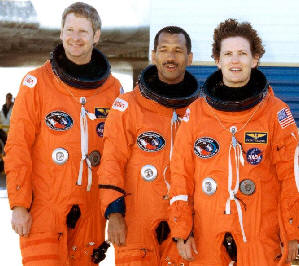
 |
NEWSROOM |
|
|
HOME LATEST NEWS - BOOKS YOU CAN READ ONLINE EDITORIALS AVIATION HISTORY |
|---|
|
|
||||
Charles Bolden, President Obama's Pick To Head NASABy Daniel Guevarra |
||||
 |
 |
 |
||
|
President Barack Obama on Saturday named Charles F. Bolden to lead NASA space agency. Bolden has a long history with the agency. A former shuttle commander, assistant deputy administrator and Deputy Administrator. Bolden flew in space four times, twice as shuttle commander. If the Senate confirms Bolden, he would be the space agency's first black administrator and the second astronaut to hold the post. Charles F. Bolden, Jr. Brig. General, USMC. Born August 19, 1946, in Columbia, South Carolina. 1964 received a bachelor of science degree in electrical science from the United States Naval Academy in 1968, and a master of science in systems management from the University of Southern California in 1977. Bolden accepted a commission as a second lieutenant in the U.S. Marine Corps following graduation from the United States Naval Academy in 1968. He underwent flight training at Pensacola, Florida, Meridian, Mississippi, and Kingsville, Texas, before being designated a naval aviator in May 1970. He flew more than 100 sorties into North and South Vietnam, Laos, and Cambodia, in the A-6A Intruder while assigned to VMA(AW)-533 at Nam Phong, Thailand, June 1972 to June 1973. Upon returning to the United States, Bolden began a two-year tour as a Marine Corps selection officer and recruiting officer in Los Angeles, California, followed by three years in various assignments at the Marine Corps Air Station El Toro, California. In June 1979, he graduated from the U.S. Naval Test Pilot School at Patuxent River, Maryland, and was assigned to the Naval Air Test Center's Systems Engineering and Strike Aircraft Test Directorates. While there, he served as an ordnance test pilot and flew numerous test projects in the A-6E, EA-6B, and A-7C/E airplanes. He has logged more than 6,000 hours flying time. Selected by NASA in May
1980, Bolden became an astronaut in August 1981. His technical
assignments included: Astronaut Office Safety Officer; Technical
Assistant to the Director of Flight Crew Operations; Special Assistant
to the Director of the Johnson Space Center; Astronaut Office Liaison to
the Safety, Reliability and Quality Assurance Directorates of the
Marshall Space Flight Center and the Kennedy Space Center; Chief of the
Safety Division at JSC; Lead Astronaut for Vehicle Test and Checkout at
the Kennedy Space Center; and Assistant Deputy Administrator, NASA
Headquarters. A veteran of four space flights, he has logged over 680
hours in space. Bolden served as pilot on STS-61C and was the mission
commander on STS-45 (March 24-April 2, 1992), and STS-60 (Feb. 3-11,
1994). SPACE FLIGHT
EXPERIENCE: STS-61C Space Shuttle Columbia. During the six-day flight
crew members deployed the SATCOM KU satellite and conducted experiments
in astrophysics and materials processing. STS-61C launched from the
Kennedy Space Center, Florida, on January 12. The mission was
accomplished in 96 orbits of Earth, ending with a successful night
landing at Edwards Air Force Base, California, on January 18, 1986. SPECIAL HONORS: Recipient of the Distinguished Flying Cross, the Defense Superior Service Medal, the Defense Meritorious Service Medal, the Air Medal, the Strike/Flight Medal (8th award), Honorary Doctor of Science Degree from the University of South Carolina (1984), Honorary Doctor of Humane Letters from Winthrop College (1986), the NASA Outstanding Leadership Medal (1992), NASA Exceptional Service Medals (1988, 1989, 1991), the University of Southern California Alumni Award of Merit (1989), and an Honorary Doctor of Humane Letters from Johnson C. Smith University (1990). |
||||
| ŠAvStop Online Magazine Contact Us Return To News | ||||
